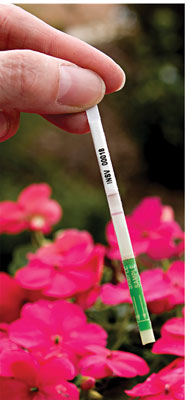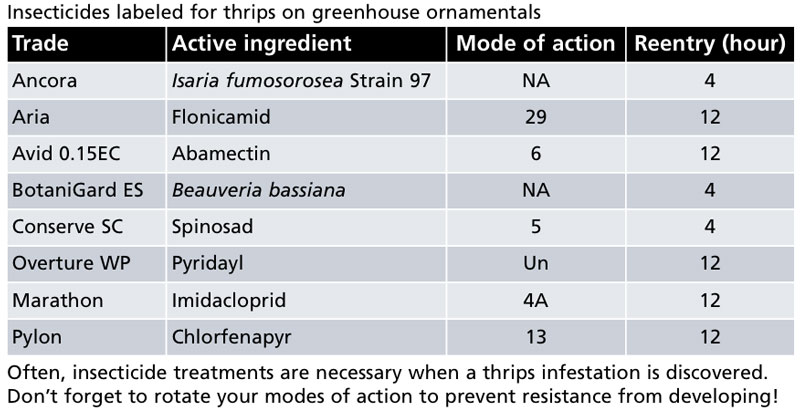4/1/2018
Staying on Top of Tospoviruses
Steven Arthurs & Kevin M. Heinz
Within plant diseases, viruses are among the most insidious. Unlike most fungal and bacterial diseases, which occur only during warm and damp conditions, viruses can occur anytime. Among the most ubiquitous are tospoviruses, which infect a wide range of ornamental and vegetable crops.
The Impatiens Necrotic Spot Virus (INSV, a type of tospovirus) is among the most serious disease of greenhouse crops, especially on annual and bedding plants, including begonia, asters, chrysanthemum, exacum, gloxinia, impatiens, ranunculus and vinca. INSV symptoms vary, but include black ring spots (impatiens), dark lesions (impatiens, cineraria, vinca), ringspots (exacum, gloxinia, cyclamen), veinal necrosis (gloxinia, aphelandra, impatiens), and stem lesions (chrysanthemum, exacum), as well as distortion, stunting and wilt of particularly susceptible varieties. Infected symptomatic plants are not marketable.
Where do they come from?
Tospoviruses are spread by thrips that enter the greenhouse from outside or may be introduced on infested plants. Several species of thrips transmit viruses, although western flower thrips is the most common vector. If the thrips are infected (and thus carrying the virus) they can inoculate your crop by feeding on it.
Moreover, if the thrips aren’t controlled, they may reproduce and spread the virus around to other previously uninfected plants. Only the immature stage of the thrips can acquire the disease by feeding on an infected plant, while the adult insect transmits it to new plants.
However, tospoviruses can also be introduced into your operation on infected propagation materials—we’ve observed INSV outbreaks occurring where no thrips are present because of this fact. In such cases, the symptoms may not show up until the plants are ready to be sold.

How to detect them?
Because different viruses cause similar symptoms, you may want to get plants tested. The contact information for your local plant clinic or professional diagnostic lab(s) should be available from your local cooperative extension office. Make sure you follow sampling and shipping instructions before sending plant material for testing.
Pictured: Plant viruses can be tested with a test kit available through commercial distributers. The strip contains a conjugated monoclonal antibody that detects specific proteins and that bind to the test lines on the strip.
As an alternative, you can purchase test kits for these diseases that give results in just a few minutes, much like a pregnancy test kit. The procedure for using these tests requires you to grind up a small section of symptomatic plant tissue in a small plastic bag and place an immunological “dipstick” (both provided in the kit) inside the bag. The antibodies on the dipstick detect different tospoviruses and a range of other common plant diseases. If you have thrips or suspect you have symptomatic plants, it may be worth testing your crop.
Steps to manage tospoviruses
Now that we have covered the plant, disease and insect triangle, we’ll outline
a few elements growers can follow to avoid tospovirus.
1. Start clean. Since infected plants cannot be treated, avoidance is an important strategy. Inspect propagation materials for thrips. Use certified virus-free stock.
2. Exclude thrips. Install and maintain insect screens around production areas. Thrips require a very fine mesh (1/150 in.). Also remove weeds inside and outside the greenhouse, since they harbor thrips that may carry the virus. Properly timed pre-emergent herbicide can provide several months of effective control.
3. Monitor. Inspect susceptible plants for thrips and virus symptoms. Place yellow or blue sticky cards among susceptible crops and inspect them for thrips. Fava beans (e.g., Little Toto) and petunias (e.g., Calypso, Super Blue Magic and Summer Madness) readily showed small brown spots where thrips have fed and are good sentinel plants for production areas. Flowering plants, such as chrysanthemums, are more attractive to thrips than those under vegetative growth.
4. Remove. Tospovirus-infected plants must be quickly rogued from the production area to reduce infection to susceptible plants. Remove older stock and pet plants from production areas. Collect, bag and discard unneeded buds and flowers that may contain thrips. When possible, allow a fallow time in the greenhouse to naturally eliminate pests. Keep the greenhouse free of weeds inside and around the perimeter.
5. Sanitize. Although plant viruses cannot generally survive outside of the plant (or insects that are carrying them), it’s probably a good idea to sanitize work areas with Virkon or other virucide, which will also help prevent the spread of other bacterial and fungal diseases.
 Sometimes chemical treatments are necessary when an infestation of thrips is starting to spread. The following materials are registered for thrips management in ornamental plants: Conserve (spinosad), Avid (abamectin), Aria (flonicamid), Pylon (chlorfenapyr), Overture (pyridayl) and BotaniGard (Beauveria bassiana).
Sometimes chemical treatments are necessary when an infestation of thrips is starting to spread. The following materials are registered for thrips management in ornamental plants: Conserve (spinosad), Avid (abamectin), Aria (flonicamid), Pylon (chlorfenapyr), Overture (pyridayl) and BotaniGard (Beauveria bassiana).
There is some evidence that INSV is on the rise. According to one large testing laboratory we spoke with, INSV is among the most frequently detected pathogen in samples submitted since 2010, with a detection rate rising from 0.2% to 1.6% of tested samples. Luckily, there are steps proactive growers can take to avoid or respond to these problems to stay on top of this pest problem. GT
Steven Arthurs (Assistant Research Scientist) and Kevin M. Heinz (Professor) work in the Department of Entomology at Texas A&M University in College Station, Texas. Dr. Arthurs is supported by a Texas A&M AgriLife Research Insect Vector Diseases Program and Dr. Heinz is regularly funded by the American Floral Endowment.